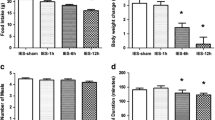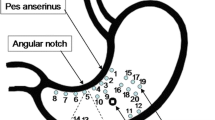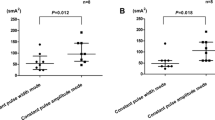Abstract
Background
Intestinal electrical stimulation (IES) has been introduced as a potential therapy for obesity. However, it is unknown whether the effects of IES on gastrointestinal motility and food intake are location-specific. The aim of this study was to assess the effects of “appendix” (cecum in dog) electrical stimulation (AES) on gastric tone, gastric emptying, and food intake in dogs.
Methods
Twelve healthy dogs were used in three experiments. In experiments 1 and 2, gastric tone and food intake were studied in six dogs implanted with a gastric cannula and one pair of stimulation electrodes in the “appendix.” Experiment 3 was performed to study gastric emptying in six dogs with a duodenal cannula and one pair of stimulation electrodes in the “appendix.”
Results
(1) AES resulted in proximal gastric distention, with gastric volume increased from 114.9 ± 10.7 mL at baseline to 301.7 ± 37.1 mL during AES (p = 0.001), and the effect was completely blocked by a nitric oxide synthase inhibitor. (2) Gastric emptying was delayed at 90 min from 69.8 ± 9.5% in the control session to 15.2 ± 3.6% in the AES session (p = 0.002). 3) AES reduced food intake (average daily intake over a 1-week period) by 55.4% (550.4 ± 17.6 g at control vs. 245.7 ± 17.1 g with AES, p < 0.001).
Conclusions
AES reduces gastric tone via the nitrergic pathway, delays gastric emptying, and inhibits food intake in healthy dogs. These data suggest the therapeutic potential of AES for obesity. Additionally, AES is technically more feasible than electrical stimulation of the stomach or duodenum because a stimulator with electrodes may be placed into the appendix via colonoscopy.



Similar content being viewed by others
References
Prentice AM. The emerging epidemic of obesity in developing countries. Int J Epidemiol. 2006;35:93–9.
World Health Organization. Obesity: preventing and managing the global epidemic. WHO Obesity Technical Report Series 894. Geneva, Switzerland: World Health Organization; 2000.
Klein S. Clinical perspectives in gastroenterology. Obesity. 2000;3:232–6.
Martin LF, Hunter SM, Lauve RM, et al. Severe obesity: expensive to society, frustrating to treat, but important to confront. South Med J. 1995;88:895–902.
Colditz GA. Economic costs of obesity. Am J Clin Nutr. 1992;55 Suppl 2:503S–7S.
Wolf AM, Colditz GA. Current estimates of the economic cost of obesity in the United States. Obes Res. 1998;6:97–106.
Consensus Development Conference Panel. Gastrointestinal surgery for severe obesity. Ann Intern Med. 1991;15:956–61.
Phillips RJ, Powley TL. Gastric volume rather than nutrient content inhibits food intake. Am J Physiol. 1996;271:R766–79.
Totte E, Hendrickx L, Pauwels M, et al. Weight reduction by means of intragastric device: experience with bioenterics intragastric balloon. Obes Surg. 2001;11:519–23.
Evans JD, Scott MH. Intragastric balloon in the treatment of patients with morbid obesity. Br J Surg. 2001;88:1245–8.
Doldi SB, Micheletto G, Perrini MN, et al. Treatment of morbid obesity with intragasrtic balloon in association with diet. Obes Surg. 2002;12:583–7.
Duggan JP, Booth DA. Obesity, overeating, and rapid gastric emptying in rats with ventromedial hypothalamic lesions. Science. 1986;231:609–11.
Wright RA, Krinsky S, Fleeman C, et al. Gastric emptying and obesity. Gastroenterology. 1983;84:747–51.
Yin JY, Ouyang H, Chen JDZ. Potential of intestinal electrical stimulation for obesity: a preliminary canine study. Obesity. 2007;15:1133–8.
Sun Y, Chen JDZ. Intestinal electrical stimulation decreases fat absorption in rats: therapeutic potential for obesity. Obes Res. 2004;12:1235–42.
Lei Y, Zhu HB, Xing JH, et al. Rectal distension modulates canine gastric tone and accommodation. Dig Dis Sci. 2005;50:2134–40.
Ohmann C, Franke C, Yang Q. Clinical benefit of a diagnostic score for appendicitis: results of a prospective interventional study. German Study Group of Acute Abdominal Pain. Arch Surg. 1999;134(9):993–6.
Shebani KO, Souba WW, Finkelstein DM, et al. Prognosis and survival in patients with gastrointestinal tract carcinoid tumors. Ann Surg. 1999;229(6):815–21. discussion 822–3.
Schmidt E, Taylor A. Acute appendicitis in dogs: an experimental study. Arch Surg. 1935;31:65–70.
Lei Y, Xing J, Chen JDZ. Effects and mechanisms of implantable gastric stimulation on gastric distention in conscious dogs. Obes Surg. 2005;15:528–33.
Lei Y, Chen JDZ. Inhibitory effects of various types of stress on gastric tone and gastric myoelectrical activity in dogs. Scand J Gastroenterol. 2009;44:557–63.
Zhao XT, Yin JY, Chen JH, et al. Inhibitory effects and mechanisms of intestinal electrical stimulation on gastric tone, antral contractions, pyloric tone, and gastric emptying in dogs. Am J Physiol Regul Integr Comp Physiol. 2009;296:R36–42.
Stunkard AJ. Current views on obesity. Am J Med. 1996;100:230–6.
Flegal KM, Carroll MD, Ogden CL, et al. Prevalence and trends in obesity among US adults, 1999–2000. JAMA. 2002;288:1723–7.
Ogden CL, Carroll MD, Flegal KM. Epidemiologic trends in overweight and obesity. Endocrinol Metab Clin North Am. 2003;32:741–60. vii.
Eckel RH. Obesity and heart disease: a statement for healthcare professionals from the nutrition committee, American heart association. Circulation. 1997;96:3248–50.
Eckel RH, Barouch WW, Ershow AG. Report of the National Heart, Lung, and Blood Institute–National Institute of Diabetes and Digestive and Kidney Diseases Working Group on the pathophysiology of obesity-associated cardiovascular disease. Circulation. 2002;105:2923–8.
Hsing AW, Sakoda LC, Chua SJ. Obesity, metabolic syndrome, and prostate cancer. Am J Clin Nutr. 2007;86(3):s843–57.
Gortmaker SL, Must A, Perrin JM, et al. Social and economic consequences of overweight in adolescence and young adulthood. N Engl J Med. 1993;329:1008–12.
House Committee on Small Business. Deception and Fraud in the Diet Industry: hearing before the Subcommittee on Regulation, Business Opportunities, and Energy, 101st Congress, 2nd Session. Washington: Government Printing Office; 1990. p. 101–50.
AACE/ACE. Position statement on the prevention, diagnosis, and treatment of obesity. Endocr Pract. 1998;4:297–330.
Suda K, Takahasi H, Fukase N, et al. Distribution and molecular forms of glucagon-like peptide in the dog. Life Sci. 1989;45:1793–8.
Miller SM, Narasimhan RA, Schmalz PF, et al. Distribution of interstitial cells of Cajal and nitrergic neurons in normal and diabetic human appendix. Neurogastroenterol Motil. 2008;20:349–57.
Lidums I, Hebbard GS, Holloway RH. Effect of atropine on proximal gastric motor and sensory function in normal subjects. Gut. 2000;47:30–6.
Paterson CA, Anvari M, Tougas G, et al. Nitrergic and cholinergic vagal pathways involved in the regulation of canine proximal gastric tone: an in vivo study. Neurogastroenterol Motil. 2000;12:301–6.
Boeckxstaens GE, Pelckmans PA, Ruytijens IF, et al. Bioassay of nitric oxide released upon stimulation of non-adrenergic non-cholinergic nerves in the canine ileocolonic junction. Br J Pharmacol. 1991;103:1085–91.
Bult H, Boechxstaens GE, Pelckmans PA, et al. Nitric oxide as an inhibitory non-adrenergic non-cholinergic neurotransmitter. Nature. 1990;345:346–7.
Allescher HD, Tougas G, Vergara P, et al. Nitric oxide as a putative nonadrenergic noncholinergic inhibitory transmitter in the canine pylorus in vivo. Am J Physiol Gastrointest Liver Physiol. 1992;262:G695–702.
Anand BK, Pillai RV. Activity of single neurons in the hypothalamic feeding centres: effect of gastric distension. J Physiol. 1967;192:63–77.
Deutsch JA, Young WG, Kalogeris TJ. The stomach signals satiety. Science. 1978;201:165–7.
Zhang J, Xu XH, Chen JDZ. Chronic tachygastrial electrical stimulation reduces food intake in dogs. Obesity. 2007;15:330–9.
Sun XR, Tang M, Zhang J, et al. Excitatory effects of gastric electrical stimulation on gastric distention responsive neurons in ventromedial hypothalamus (VMH) in rats. Neurosci Res. 2006;55:451–7.
Zhang J, Zhu H, Chen JDZ. Central neuronal mechanisms of intestinal electrical timulation: effects on duodenum distention-responsive (DD-R) neurons in the VMH of rats. Neurosci Lett. 2009;457:27–31.
Tang M, Zhang J, Xu L, et al. Implantable gastric stimulation alters expression of oxytocin- and orexin-containing neurons in the hypothalamus of rats. Obes Surg. 2006;16:762–9 (Tang M and Zhang J contributed equally).
Xu JY, McNearney TA, Chen JDZ. Gastric/intestinal electrical stimulation modulates appetite regulatory peptide hormones in the stomach and duodenum in rats. Obes Surg. 2007;17:406–13.
Acknowledgments
This work was supported in part by Oklahoma Center for the advancement of Science and Technology (OCAST) Grants HR08-060.
Conflict of interest
The authors declare that they have no conflict of interest.
Author information
Authors and Affiliations
Corresponding author
Rights and permissions
About this article
Cite this article
Lei, Y., Chen, J.D.Z. A Potential and Novel Therapy for Obesity: “Appendix” Electrical Stimulation in Dogs. OBES SURG 21, 397–403 (2011). https://doi.org/10.1007/s11695-010-0281-1
Published:
Issue Date:
DOI: https://doi.org/10.1007/s11695-010-0281-1




